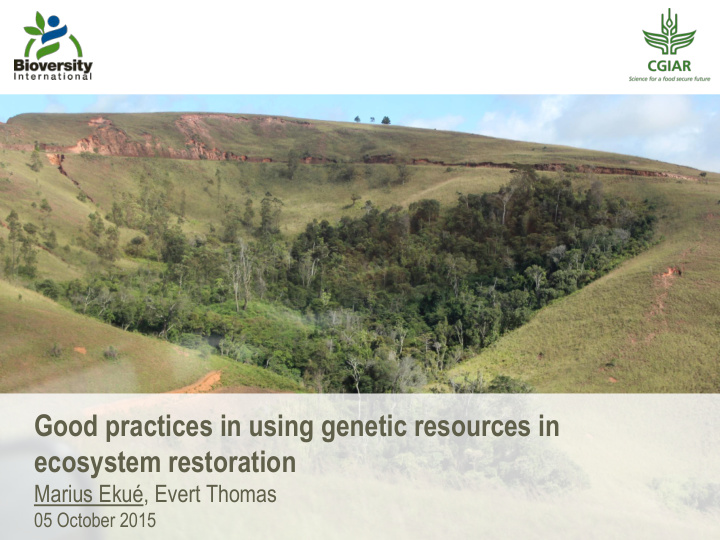



Good practices in using genetic resources in ecosystem restoration Marius Ekué, Evert Thomas 05 October 2015
Ecological Restoration The scale of on-going and planned restoration projects is enormous - Aichi 15 ~ 300 Mha by 2020 Bonn challenge 150 Mha by 2020 - Initiative 20x20 20 Mha by 2020 in Latin America and the Caribbean - Vision 25x25: 25 Mha by 2025 in Africa small holder farmers land - Countries level initiatives (e.g. Benin: 1 tree / inhabitant = 10 Millions - trees) Huge ecological, social and economic opportunities: Contributes to objectives of 3 Rio conventions: biodiversity conservation, combating desertification, climate change mitigation and adaptation + ecosystem services, income generation…
Risks of failure • Initial mortality • Poor growth • Delayed mortality or after extreme climate events (eg. Plantation of 30.000ha of Pinus pinaster in France with non-frost resistant germplasm from Spain destroyed in winter 84/85) Reduction in quantity and • quality of seeds in established tree stands, compromising viability
How to reduce the risks of failures Appropriate species • choices Genetic principles in • selection of planting material Good silvicultural • practices
Genetic diversity is the foundation for: Survival of trees on the restoration site Origin of seed must match site conditions to ensure • adaptedness Promoting good growth, reproduction and resilience over generations Seed sources must be genetically diverse enough to • avoid inbreeding and to contain sufficient genetic building blocks for natural selection
A model for guiding restoration practice
Prunus africana
A model for guiding restoration practice
A model for guiding restoration practice
Vitellaria paradoxa Phylogeography and demographic history Allal et al. Heredity (2011)
Concluding remarks • Aichi Target 15: quantitative but also qualitative • One of the decisions of 12th COP of the CBD: “[...] Invites Parties and other Governments, intergovernmental organizations and other relevant organizations [...] to give due attention to both native species and genetic diversity in conservation and restoration activities , while avoiding the introduction and preventing the spread of invasive alien species ” 14
Concluding remarks • Need for political commitment: create demand for good quality seeds of native species through regulatory frameworks and resource allocation • Decision making by restoration practitioners needs to be knowledge-based: guidelines and protocols have to be available in useful format • Apply adaptive management: learn from mistakes and failures and continuously integrate new knowledge
Concluding remarks • Landscape approach to promote connectivity (gene flow and species migration) • Evaluate effectiveness of different methods to establish viable ecosystems and restore genetic diversity: adequate indicators and monitoring protocols • Great potential of restoration for contributing to conservation goals (endangered species, assisted migration, etc) • 16
Recommend
More recommend